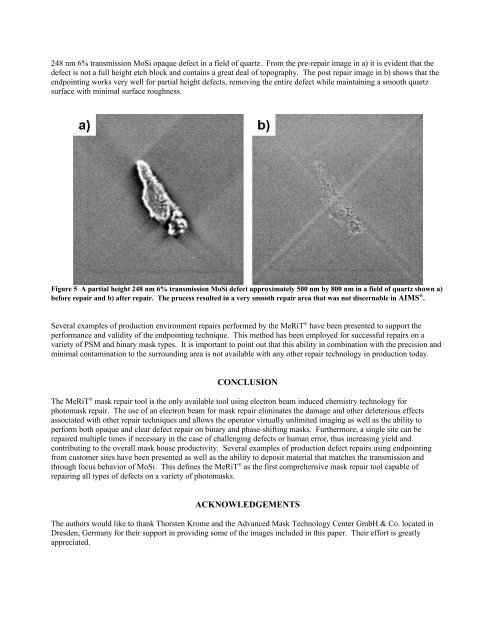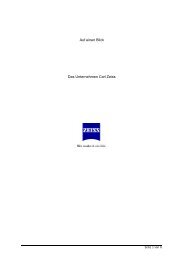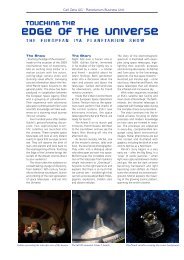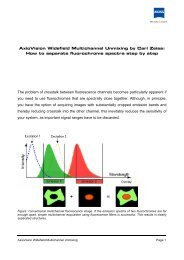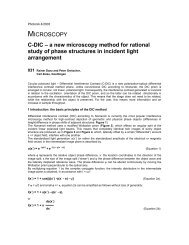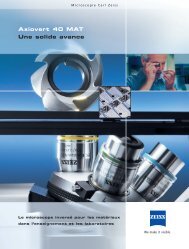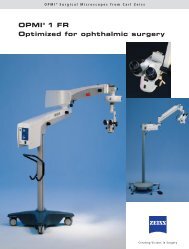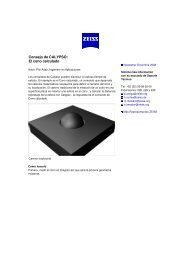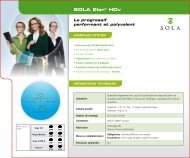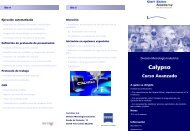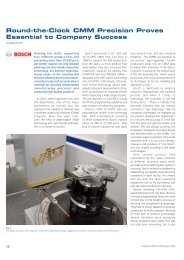Demonstration of the Advantages of Electron Beam ... - Carl Zeiss SMT
Demonstration of the Advantages of Electron Beam ... - Carl Zeiss SMT
Demonstration of the Advantages of Electron Beam ... - Carl Zeiss SMT
You also want an ePaper? Increase the reach of your titles
YUMPU automatically turns print PDFs into web optimized ePapers that Google loves.
248 nm 6% transmission MoSi opaque defect in a field <strong>of</strong> quartz. From <strong>the</strong> pre-repair image in a) it is evident that <strong>the</strong><br />
defect is not a full height etch block and contains a great deal <strong>of</strong> topography. The post repair image in b) shows that <strong>the</strong><br />
endpointing works very well for partial height defects, removing <strong>the</strong> entire defect while maintaining a smooth quartz<br />
surface with minimal surface roughness.<br />
Figure 5 A partial height 248 nm 6% transmission MoSi defect approximately 500 nm by 800 nm in a field <strong>of</strong> quartz shown a)<br />
before repair and b) after repair. The process resulted in a very smooth repair area that was not discernable in AIMS ® .<br />
Several examples <strong>of</strong> production environment repairs performed by <strong>the</strong> MeRiT ® have been presented to support <strong>the</strong><br />
performance and validity <strong>of</strong> <strong>the</strong> endpointing technique. This method has been employed for successful repairs on a<br />
variety <strong>of</strong> PSM and binary mask types. It is important to point out that this ability in combination with <strong>the</strong> precision and<br />
minimal contamination to <strong>the</strong> surrounding area is not available with any o<strong>the</strong>r repair technology in production today.<br />
CONCLUSION<br />
The MeRiT ® mask repair tool is <strong>the</strong> only available tool using electron beam induced chemistry technology for<br />
photomask repair. The use <strong>of</strong> an electron beam for mask repair eliminates <strong>the</strong> damage and o<strong>the</strong>r deleterious effects<br />
associated with o<strong>the</strong>r repair techniques and allows <strong>the</strong> operator virtually unlimited imaging as well as <strong>the</strong> ability to<br />
perform both opaque and clear defect repair on binary and phase-shifting masks. Fur<strong>the</strong>rmore, a single site can be<br />
repaired multiple times if necessary in <strong>the</strong> case <strong>of</strong> challenging defects or human error, thus increasing yield and<br />
contributing to <strong>the</strong> overall mask house productivity. Several examples <strong>of</strong> production defect repairs using endpointing<br />
from customer sites have been presented as well as <strong>the</strong> ability to deposit material that matches <strong>the</strong> transmission and<br />
through focus behavior <strong>of</strong> MoSi. This defines <strong>the</strong> MeRiT ® as <strong>the</strong> first comprehensive mask repair tool capable <strong>of</strong><br />
repairing all types <strong>of</strong> defects on a variety <strong>of</strong> photomasks.<br />
ACKNOWLEDGEMENTS<br />
The authors would like to thank Thorsten Krome and <strong>the</strong> Advanced Mask Technology Center GmbH & Co. located in<br />
Dresden, Germany for <strong>the</strong>ir support in providing some <strong>of</strong> <strong>the</strong> images included in this paper. Their effort is greatly<br />
appreciated.


